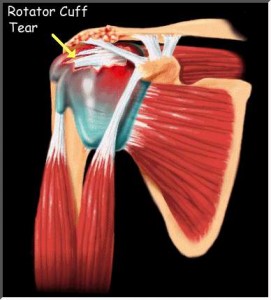In the first part of this post, I discussed ‘Sprains’. In this post, I will be discussing ‘Strains’.
Strain
 A Strain is a tear in a muscle or tendon due to excessive tension through the tissue. Strains often occur at the musculotendinous junction. Muscle strains often occur during heavy lifting or during explosive, fast movements. Strains often occur at a time of muscular and neurological fatigue. Therefore, strains occur more often towards the end of sporting events. They can also be caused by an impact injury or compression. A poor warm-up by the athlete can increase the likelihood of a strain. As muscles and tendons have a better blood supply than ligaments and muscles have a greater blood supply than tendons, muscles tend to heal faster than tendons and tendons faster than ligaments.
A Strain is a tear in a muscle or tendon due to excessive tension through the tissue. Strains often occur at the musculotendinous junction. Muscle strains often occur during heavy lifting or during explosive, fast movements. Strains often occur at a time of muscular and neurological fatigue. Therefore, strains occur more often towards the end of sporting events. They can also be caused by an impact injury or compression. A poor warm-up by the athlete can increase the likelihood of a strain. As muscles and tendons have a better blood supply than ligaments and muscles have a greater blood supply than tendons, muscles tend to heal faster than tendons and tendons faster than ligaments.
A first-degree tear is a minor partial tear. Some noticeable affect on function is likely although more so during high intensity activity. Mild to moderate pain will occur during contraction and stretching. The strength of the muscle may be reduced with a possible tightening of the muscles with potential swelling and tenderness with palpation. Healing can occur very quickly.
A second-degree tear is a severe partial tear. Function is impaired to a greater degree. Moderate to strong pain will occur during contraction, stretch and palpation. Muscle strength will be reduced and spasm of the affected and surrounding muscles is likely. Moderate to major swelling can occur and function will be greatly affected. Healing can take 3-6 weeks with good treatment.
A third degree tear is a total rupture. This type of injury is due to a severe over-stretching or very forceful contraction. Athletes that may be of a higher risk are Olympic weight-lifters, body builders and track and field sprinters. Signs and symptoms include severe pain (local and diffuse), loss of function, weakness, marked swelling, spasm in adjacent muscles and palpable bunching of the muscle fibres. This injury normally requires surgical intervention and can take 2-3 months or longer to recover.
Stay tuned for part 3, when I will be discussing stress fractures…
